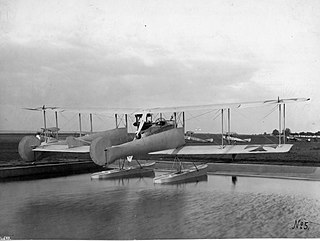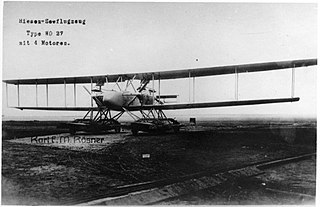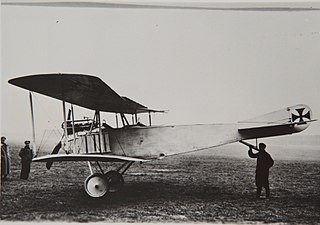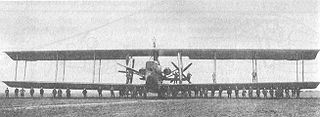Related Research Articles

The AGO C.I was a First World War German pusher reconnaissance biplane that used a pod-and-boom configuration.

The Friedrichshafen G.I was a prototype heavy bomber aircraft that was built in Germany by Flugzeugbau Friedrichshafen in 1915. It was Karl Gehlen's first design for the company, and although it was not produced in quantity, it provided the foundation for the later, highly successful bombers culminating in the G.III.

The Friedrichshafen G.II was a medium bomber aircraft that was designed and manufactured in Germany during World War I by Flugzeugbau Friedrichshafen. The plane was used by the Luftstreitkräfte for tactical and limited strategic bombing operations.

Deutsche Flugzeug-Werke, usually known as DFW, was a German aircraft manufacturer of the early twentieth century. It was established by Bernhard Meyer and Erich Thiele at Lindenthal in 1910, and initially produced Farman designs under licence, later moving on to the Etrich Taube and eventually to its own designs. One of these, the DFW C.V reconnaissance aircraft, was produced to the extent of several thousand machines, including licence production by other firms. Plans to develop civil aircraft after the war proved fruitless, and the company was bought by ATG shortly thereafter.
The DFW C.I was a German reconnaissance aircraft produced during World War I. Derived from the company's B.I design of 1914, the C.I kept the same basic fuselage design, but dispensed with the B.I's distinctive crescent-shaped wings, replacing them with wings with conventional straight leading edges. Engine power was also increased from 90-112 kW (120-150 hp).

The DFW C.IV, DFW C.V, DFW C.VI, and DFW F37 were a family of German reconnaissance aircraft first used in 1916 in World War I. They were conventionally configured biplanes with unequal-span unstaggered wings and seating for the pilot and observer in tandem, open cockpits. Like the DFW C.II before them, these aircraft seated the gunner to the rear and armed him with a machine gun on a ring mount. Compared to preceding B- and C-class designs by DFW, however, the aerodynamics of the fuselage were more refined, and when coupled with more powerful engines, resulted in a machine with excellent performance.
The DFW R.I,, was a prototype German bomber aircraft of World War I.

The DFW R.II was a German bomber aircraft of World War I. It was developed at a request by the Luftstreitkräfte in spring 1917 after their experience with the R.I had been generally positive, but only two were ever built despite six being ordered.

The Gotha WD.3 was a pusher reconnaissance floatplane built in prototype form in Germany in 1915.

The Gotha WD.27 was a patrol seaplane developed in Germany during World War I. It was a large, four-engine aircraft with the same general layout as the WD.22; a conventional seaplane with engines grouped in tractor-pusher pairs on the lower wings. Contemporary records show three German Navy serial numbers allocated to the type, but only one of these may have been flown.

The Albatros B.III,, was a German World War I reconnaissance biplane, built by Albatros Flugzeugwerke as the Albatros LDD.

The Rumpler G.I was a bomber aircraft produced in Germany during World War I, together with refined versions known as the G.II and G.III.

The Siemens-Schuckert R.VIII was a bomber aircraft designed and built in Germany from 1916.

The Albatros C.II was a 1910s German military pusher reconnaissance biplane designed and built by Albatros Flugzeugwerke. Only one aircraft was built and the type did not enter production.

The Schütte-Lanz G.I was a large, twin engine, pusher configuration, experimental biplane built in Germany early in World War I. Only one was completed.
The DFW D.I was a German fighter aircraft produced during World War I.
The DFW Dr.I was a prototype German fighter aircraft built during World War I.
References
- ↑ Treadwell, Terry, 2010. German and Austro-Hungarian Aircraft Manufacturers 1908-1918. Stroud: Amberley Publishing.
- Taylor, Michael J. H. (1989). Jane's Encyclopedia of Aviation. London: Studio Editions.
- World Aircraft Information Files. London: Bright Star Publishing.
| This military aviation article is a stub. You can help Wikipedia by expanding it. |